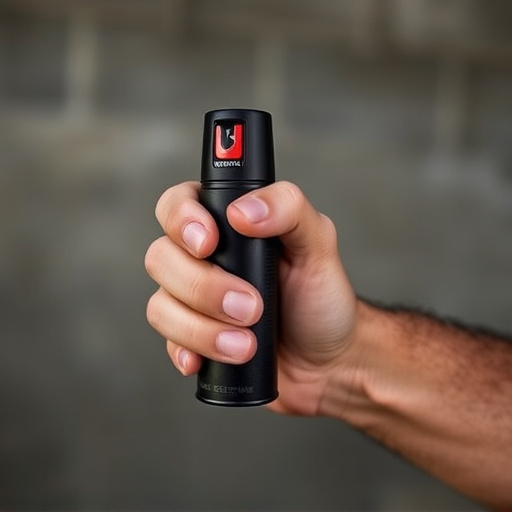Pepper spray, a powerful law enforcement and self-defense tool, relies on proper storage to maintain its effectiveness. Cool, dry conditions below 30°C (86°F) with low humidity are ideal for preserving potency, as recommended by manufacturers for shelf lives of 2-5 years. Professional police-grade sprays have higher capsaicin concentrations and enhanced packaging, while consumer varieties have shorter shelf lives due to less robust formulations. Regular inspection is crucial, checking for signs of degradation or contamination. Optimizing storage conditions and understanding environmental impacts are key to ensuring pepper spray remains potent and safe for use when needed.
“Uncover the power behind police-grade inflammatory pepper spray compounds, a tool crucial for law enforcement and self-defense. This comprehensive guide delves into the intricate chemistry, distinguishing it from standard varieties. We explore key differences, storage best practices for optimal effectiveness, and factors influencing shelf life—essential knowledge for responsible management.
Learn about safe handling and disposal guidelines, ensuring you’re equipped with the insights needed to navigate this potent yet vital tool, ‘Pepper Spray Storage and Shelf Life’.”
- Understanding Pepper Spray Chemistry: The Compound Breakdown
- Police Grade vs Standard Pepper Spray: Key Differences
- Storage Considerations for Optimal Effectiveness
- Factors Influencing Shelf Life: What You Need to Know
- Safety and Disposal Guidelines: Responsible Management
Understanding Pepper Spray Chemistry: The Compound Breakdown
Pepper spray, a powerful law enforcement tool, is a chemical compound designed to cause temporary blindness and disorientation, making it an effective deterrent. Understanding its chemistry involves delving into the specific ingredients that create this intense reaction. The primary active ingredient in most pepper sprays is capsaicin, derived from chili peppers. This compound stimulates nerve endings, leading to a burning sensation and subsequent tears, runny nose, and difficulty breathing.
When it comes to pepper spray storage and shelf life, proper handling is crucial. These products should be kept in cool, dry places, away from direct sunlight and heat sources. Many manufacturers recommend storing them at temperatures below 30°C (86°F) and in locations with low humidity. Following these guidelines ensures the potency and effectiveness of the spray remain optimal over its intended shelf life, which typically ranges from 2 to 5 years, depending on the brand and formulation.
Police Grade vs Standard Pepper Spray: Key Differences
Police-grade pepper spray is designed for professional law enforcement use, offering a more potent formula than standard consumer varieties. The primary difference lies in its active ingredients and overall strength, which are specifically selected to incapacitate individuals while minimizing harm. This specialized spray typically contains higher concentrations of capsaicin, the compound responsible for the burning sensation associated with chili peppers. As a result, it provides a more effective response during high-risk situations.
When considering pepper spray storage and shelf life, police-grade options generally have stricter requirements. They often come with enhanced packaging designed to maintain potency and prevent contamination, ensuring optimal performance when needed most. In contrast, standard consumer sprays may have shorter shelf lives due to less robust formulations, making proper storage and handling even more critical for maintaining their effectiveness over time.
Storage Considerations for Optimal Effectiveness
Proper storage is paramount to maintaining the optimal effectiveness of pepper spray. It’s crucial to keep it in a cool, dry place away from direct sunlight and extreme temperatures. Humidity control is also essential; storing pepper spray in areas with high humidity can lead to premature degradation of the compound. Additionally, ensure the container remains sealed to protect against moisture ingress and contamination.
When it comes to shelf life, pepper spray manufacturers typically provide guidelines for both safety and efficacy. While many commercial-grade varieties can last up to 3 years under ideal conditions, regular checking is recommended to verify the product’s integrity. Discoloration, changes in consistency, or unusual odors are indicators that the spray might have degraded, necessitating replacement.
Factors Influencing Shelf Life: What You Need to Know
The shelf life of pepper spray is influenced by several factors, crucial for both law enforcement agencies and individuals seeking self-defense options. One primary consideration is pepper spray storage: proper containment and temperature control are essential to maintain potency. Extreme heat or exposure to sunlight can degrade the active ingredients, reducing the spray’s effectiveness. Hence, storing pepper spray in cool, dry places away from direct light is vital.
Additionally, environmental conditions play a significant role. Humidity levels and air quality can impact the spray’s stability. High humidity may accelerate degradation, while polluted environments could introduce contaminants. Ensuring proper pepper spray storage involves understanding these factors to guarantee optimal shelf life.
Safety and Disposal Guidelines: Responsible Management
Pepper spray, a powerful tool for law enforcement and self-defence, requires careful handling and responsible management to ensure safety. When it comes to storage and disposal, proper guidelines must be followed to maintain effectiveness and prevent accidental exposure or harm. Pepper spray should be stored in a cool, dry place, away from direct sunlight and heat sources. It is essential to keep the containers tightly closed to protect against moisture and environmental contaminants that could degrade the compound’s potency.
The shelf life of pepper spray varies depending on the brand and formulation, but generally, it remains effective for 2-5 years when stored appropriately. Regular inspection is recommended to ensure the spray can still achieve its intended impact. Disposal should be done responsibly by following local regulations. Many areas require that used pepper spray be disposed of as hazardous waste to prevent potential harm to the environment and people.
Pepper spray is a powerful tool, but its effectiveness depends on proper storage and understanding its shelf life. By knowing the chemical composition, distinguishing police-grade products, and adhering to safety guidelines, users can ensure optimal performance. Regular maintenance and awareness of factors impacting longevity are essential for responsible pepper spray management, making it a more effective solution for personal protection.
